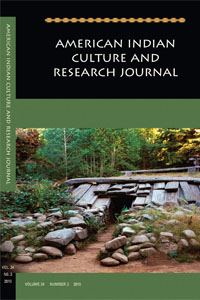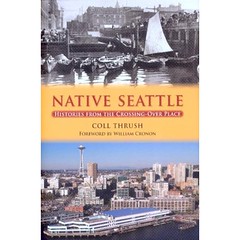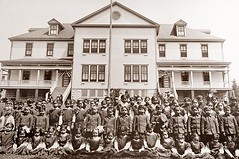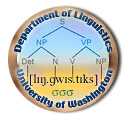Seattle, WA 98107
206-784-6665
Dushuyay Research is a trusted consulting service for heritage research and preservation. Its services cover a broad spectrum of needs dealing with language recovery, history, photographs, archives, interpretation and other cultural resource issues. Located in the Ballard neighborhood of Seattle, Dushuyay Research serves not only the Pacific Northwest, but also the entire Pacific Coast from British Columbia to California.
Company History

Dushuyay Research (also doing business as Dushuyay Publications and Research) was founded in 1981 by Nile Thompson and Carolyn Marr as Dushuyay Publications. The initial project was the publication of the popularly acclaimed book Crow’s Shells: The Artistic Basketry of Puget Sound. Since that time, Dushuyay Research has provided a variety of professional services to Indian tribes, museums, university presses and businesses. These services include linguistic research and language planning, history research and writing (e.g. tribal histories, school histories, business histories), photographic services and text editing, exhibit research and design, cultural resource assessment and preservation planning, and legal anthropological research and testimony.
Click on a link above to learn more about Dushuyay Research. Click ABOUT US to find out more about the partners, Nile Thompson and Carolyn Marr. Look below to see exciting recent news.
2014

In one of his specializations, Nile Thompson reviewed a new book on learning strategies for disappearing indigenous languages.
The review appeared in American Indian Culture and Research Journal: Vol. 38, No. 3 (2014).
Bringing Our Languages Home: Language Revitalization for Families. Edited by
Leanne Hinton. Reviewed by Nile Robert Thompson.
May 2013

Paula Becker, author and a staff historian for HistoryLink.org, provided a list of her favorite regional/local history books (see the Books section of the May 8, 2013 Crosscurrent.com). Leading off her list of seven favorites is one written by Dushuyay Research staff (emphasis added).
There are gorgeous books about so many aspects of Seattle's history; we benefit from a robust community of writer-historians. A few of my favorites are Nile Thompson and Carolyn Marr’s “Built For Learning: Seattle Public School Histories, 1862-2000”; Caroline T. Swope, “Classic Houses Of Seattle, High Style to Vernacular, 1870-1950”; Lawrence Kreisman and Glenn Mason, “The Arts And Crafts Movement In The Pacific Northwest”; Jeffrey Karl Ochsner, editor, “Shaping Seattle Architecture”; Walt Crowley, “Rites Of Passage: A Memoir of the Sixties In Seattle”; Monica Sone, “Nisei Daughter”; and Paul Dorpat's three collections of his Seattle Times “Now And Then” columns, which are fabulous for newcomers because they help build a visual matrix of Seattle's historic built environment.
The Department of Linguistics at the University of British Columbia and UBC Working Papers in Linguistics announced the launching of their On-line Archive of Papers for the International Conference on Salish (and Neighbo(u)ring) Languages. The archive currently covers papers for the years 1967-1999. Included in the archive are nine papers by Nile Thompson on the Twana and Puget Sound Salish (Whulshootseed) languages, with topics ranging from ethnobotany to phonology, morphology, dictionary construction, female speech, health education and syntax.
"Skokomish phonology I: Vowels, Semivowels and labialized consonants" (with addendum) ICSNL Volume 11, Year 1976
"A note on Skokomish plant names" ICSNL Volume 12, Year 1977
"Possession in Twana" ICSNL Volume 12, Year 1977
"tuwaduqucid wel dxwlešucid: a comparative dialect study" ICSNL Volume 14, Year 1979
"A contribution to Puget Salish lexical studies" ICSNL Volume 16, Year 1981
"Female indicators in the Twana language" ICSNL Volume 19, Year 1984
"On the Need for Ethnographic Information in Native American Dictionary Construction" ICSNL Volume 24, Year 1989The archive may be accessed at http://www.linguistics.ubc.ca/icsnl
Coauthored with Sloat, C. Dale
"Southern Coast Salish Oral Literature and Health Education" ICSNL Volume 29, Year 1994
Coauthored with Armagost, James L.
“The Agent-Patient Restriction in Puget Sound Salish: A Call for Further Research” ICSNL Volume 31, Year 1996
July 2010
Nile Thompson and co-author Dale Sloat have an article in the Winter/Spring issue of the Nordic Heritage Museum Historical Journal. Entitled “Nicholas Delin and the Choice of Commencement Bay”, it examines the life of an early Swedish settler in what is now Tacoma and reveals how his membership in the Masonic Lodge in Olympia influenced his selection of Commencement Bay for his mill. The article corrects the common misconceptions that Delin arrived there in 1852 and that he was the first to stake out property there. Rather, Delin settled his claim in May 1853, next to land claimed by John Allen, and the mill went into operation in early July.

April 2009
At the annual awards banquet of the Association of King County Heritage Organizations (AKCHO) on April 28th, Carolyn Marr was presented the Williard Jue Memorial Award for her 23 years of service at the Museum of History and Industry. She has provided assistance to individuals and groups visiting the library to work on a wide spectrum of history projects.
The Willard Jue Memorial Award is presented to individuals in two possible categories - paid staff and volunteers. The Willard Jue Memorial Award winners are individuals who have made outstanding contributions, provided exceptional leadership, and demonstrated excellence in duration, quality, or spirit of service.
February 2009
Carolyn Marr is the curator of a new exhibit, Photographing the Fair: The Alaska-Yukon-Pacific Exposition Photos of Frank H. Nowell and Others, which will be at the Museum of History and Industry in Seattle from March 7 to December 31, 2009. For a related story and a photo of Carolyn at work, go to:
January 2009
Carolyn Marr has an essay in the Seattle Art Museum's new exhibit catalog, S'abadeb -- The Gifts: Pacific Coast Salish Art and Artists. Carolyn contribution is entitled "Objects of Function and Beauty: Basketry of the Southern Coast Salish". Carolyn concludes:
The act of creating a basket unites the maker with his or her culture, continuing a tradition that has been passed on [through] countless generations. Although today’s basket makers are few in number, they represent an art form with ancient roots, one that has survived decades of social change. Taking a close look at Coast Salish baskets from the past helps us to gain an appreciation for the incredible depth and breadth of this tradition. Today’s basket makers may change some of the materials, they may create new designs or change the shapes of the baskets, but they nevertheless remain closely connected to the masters …

For a description of the book go to:
October 2008
Native Seattle Receives Washington State Book Award
Nile Thompson worked with historian Coll Thrush (University of British Columbia) to produce a gazetteer of Indian place names of Seattle. Entitled "An atlas of indigenous Seattle", it appears as an appendix (pp. 209-55, 289-91) to Thrush's Native Seattle: Histories from the Crossing-Over Place (University of Washington Press) which came out in April 2007.

Native Seattle: Histories from the Crossing-Over Place has been awarded the 2008 Washington State Book Award for History and Biography.
"Native Americans played a large, rich and vital role in the founding and development of Seattle ..." the committee said. ... "The judges were impressed by this new and different telling of the history of Seattle and by the brilliant 'Atlas of Indigenous Seattle' compiled by Thrush and linguist Nile Thompson." (excerpts, University of Washington Press, Fall 2008)For more information on "An atlas of indigenous Seattle" and on the ethnogeographic services that Dushuyay Research can provide, click on SERVICES and scroll down to the "Cultural Resources" heading.
February 2008
Carolyn Marr's research on Indian boarding schools in the Pacific Northwest is the first of five resources provided with the February 3, 2008 Seattle Times article, "A Lesson in Healing -- Indian Boarding Schools: Tribes Confront a Painful Legacy."

Read a related Seattle Times article at:
Nile Thompson was asked by the local newspaper to contribute a historical overview of the Indians who were the original residents of Ballard. "Early History of the Shilsholamish", appeared in the July 31, 2007 Ballard News Tribune. The article reads in part:
Early visitors who came to the area that would become Seattle did not think of it in terms of Starbucks, Microsoft, Boeing or Costco. Those who came from the north in large war canoes, however, did view it as a land of plenty - plenty for them to plunder. These teams of hardened combatants swept down on Salish villages whose only defense was a single warrior or "tough guy". The raiding Indians from upper British Columbia and southeast Alaska changed the cultural geography of the Puget Sound and Hood Canal drainage basins in the late 18th and early 19th centuries. Some villages were fortified and others moved, watch posts were established at good vantage points and new escape routes were instituted. ...
January 2007
Nile Thompson was asked to contribute some of his memories of his days in the Linguistics Department at the University of Washington. Part of his recollections included how he started working with the Skokomish Indian Tribe on Hood Canal.
In 1973 I heard from contacts in the Anthropology Department that they had been contacted by a former student (Karen James) about trying to find someone to work with the last speakers of the Twana language on the Skokomish Indian Reservation. I met with the tribe and we reached a mutual agreement that we’d look for funding to make something happen. ... I [later began with] a grant from the Jacobs Research Fund (about $500, as I recall) for research on ethnobotany. My main informant was Louisa Jones Pulsifer (born in 1886) who at age 14 had become the second wife of a famous Indian doctor. She was also one of the last traditionally trained basket makers. ...Click the link below to read the rest of his "Reflections" on the Department of Linguistics at the University of Washington during the 1970s and 1980s in the department's January 2007 newsletter (No. 5, Vol. 1).

